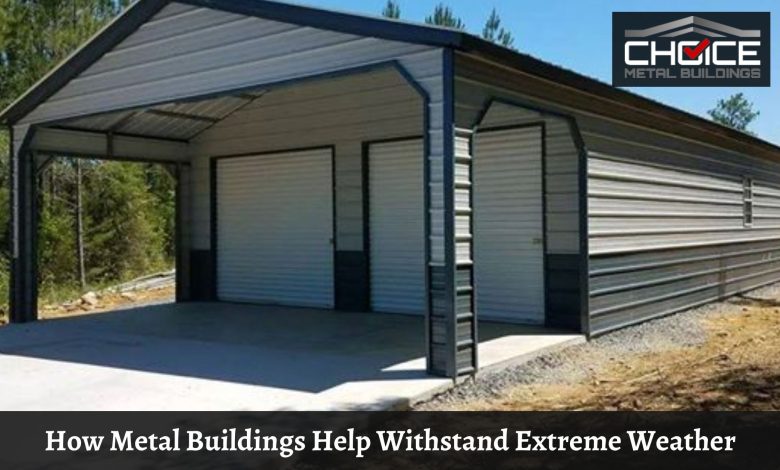How Metal Buildings Help Withstand Extreme Weather

Metal buildings have long been the choice of building for people who desire a durable yet straightforward structure with low maintenance. Additionally, they are used in construction applications where there is a risk of exposure to the extreme weather conditions found in certain areas. These include high wind, heavy rains and snowfall, extreme cold or hot spells, and hurricanes.
A metal building is essentially many layers of steel interconnected to form a solid and safe structure. A good design, proper construction, and the use of quality materials make such a structure weather-proofed. Several homeowners and storage warehouse owners living in Pilot Mountain, NC, prefer metal building installation as it has the advantages of low cost, fire resistance, and durability.
This blog will go through how metal buildings help withstand extreme weather.
What is the structure of a metal building?
The structure of a metal building is mainly composed of three main elements, the roof, sidewalls, and foundations.
Roof
The durability and robustness of the roof are essential in protecting the building against damage during heavy rain, snowfall, hurricanes, tornadoes, or high winds.
The roof can be made from sheet metal that is thin enough to bend easily but tough enough not to crack or break under load. The ridge height can also vary depending on location and climate conditions.
Sidewalls
Metal steel buildings are similar to steel structures with no need for insulation. This is because the metal walls on their own provide protection against weather extremes.
However, if you are concerned with reducing the effects of heat or cold, it is possible to attach wall insulation panels inside the sidewalls.
Foundations
A strong foundation system is essential for all. It is mainly composed of steel beams creating a base on which the structure rests. These beams are usually placed at four-foot intervals and consist of two ‘L’ shaped pieces that fit together to anchor the building firmly.
They must be robust enough to support the load on top, such as snow or the roof’s weight. It should have a solid drainage system to prevent rotting or corrosion, which can weaken the structure over time.
Also, there must be no sharp objects around the base of the building as this can cause damage or injury.
How do metal buildings protect you from extreme weather?
Resistance to Winds
Metal buildings are usually stiffer and taller than wood structures. It reduces the amount of vibration under wind pressure, increasing their resistance against damage. These buildings typically withstand hurricanes without severe damage to the structure or interior.
If you stay in an area that is at risk from a hurricane or other extreme weather conditions, it may be advisable to have a building specifically designed to withstand high winds. An expert metal building engineer can develop the structure with strength in mind, making it very durable.
Fire Resistance
Another critical consideration is fire resistance. Sheet metal has little to no explosive properties, and as such, it does not support the spread of a fire. In addition, if a building is under construction or remodeling, you can take advantage of temporary shutters to ensure no gaps by which the exterior wall can be exposed to weather conditions.
Able to withstand heavy snow
A metal building can withstand up to around one and a half feet of heavy snow without damage. This is because the roof’s strength and the insulated side walls allow no softening or cracking, which is common with wooden structures subjected to such weight. Also, this may add insulation value during cold months that can save energy costs. However, it would be advisable to avoid leaving snow on the roof during high winds.
High strength steel structure withstands Hurricane
In the act of a hurricane, you must close all windows and doors to reduce injury from flying debris or shattered glass. You can go for custom steel buildings that are less likely to be destroyed in the face of high winds (it is doubtful they will shatter completely). They will also be less likely to suffer water damage, rot, or rust.
Resistant to Flooding
The roof and sidewalls do not absorb any moisture and will typically never rot or rust over time, making them durable against rain, snow, or floods. Water can drain off quickly through gutters or downspouts that are easy to maintain.
Buildings with sheet metal walls have very little flex when water and wind blow through them. It helps keep the building’s integrity and contents dry and undamaged by floodwaters or high winds. Also, it reduces the weight of rain on the roof, which leads to better insulation. This will reduce energy costs compared with a wooden structure affected by moisture over time.
Conclusion
Metal buildings can provide security for your property and safety for occupants against extreme weather conditions. These buildings are ideal for all kinds of climates because they can withstand extreme temperatures, high winds, and heavy snow.
They are more durable than other building materials, and if installed by a professional metal building engineer in NC, they will provide the occupants with long-lasting protection for years. So why wait?



